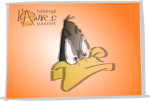How to Send an E-mail : A 1984 British Television Broadcast Explains This “Simple†Process

Earlier this month, the world got news of the death of a man whose name many of us had never heard but whose act of innovation shaped what we do every day. “When historians of the future study the ways information technology affected people’s lives in the late 20th century,” said his Economist obituary , “they will surely recognise e-mail as one of the most profound. Today, about 2.5m e-mails are sent every second. The first e-mail of all, though” — to be precise, “the first message between terminals attached to separate CPUs, albeit that these two computers stood side-by-side in the same room” — “was sent 45 years ago by Ray Tomlinson .”
Fifteen years after that quietly history-making transmission, e-mail had evolved to the point that it had become a subject in the news. This 1984 segment of the Thames Television computer show Database shows how one early-adopting couple, Pat and Julian Green of north London, communicate with the world by connecting their computer to, of all things, the telephone line. “It’s simple, really,” says Julian, unplugging a British Telecom cable from one socket and plugging it into a modem, plugging a different wire from the modem into the first socket, switching on the modem, and then hand-dialing the number of a “main computer” — with his rotary phone. “Extremely simple,” he reiterates.
What can they do on Micronet, their service provider, once connected ? They might read the news, have a look at “reviews of the software that’s currently available” and even download some of it, or use the feature that Pat (in addition to her use of the computer for “keeping household records, such as what I have in the freezer, and people’s telephone numbers and addresses,” as well as “a word processor for my letters, which always come out perfect now”) describes as most exciting of all : “the mailbox where I write to other people.” We see how she can use this new electronic mail to ask her doctor to refill a prescription, and even to send a message to the Database studio.
All this must have intrigued the viewers of the day, who, if they had their own computers at the ready, could even “download” software straight from the broadcast by recording the tone that plays over the show’s end credits. (As long as their computers were BBC Micros , that is, at least in this particular episode.) The past 32 years have seen enthusiasm for new technology spread all across the world, turning us all, in some sense, into Pat and Julian Greens. Today we marvel at all what we can do with our smartphones, devices that would’ve seemed magical in 1984, but in three decades from now, even our current technological lives will surely look quainter than anything in the Database archives.
Related Content :
From the Annals of Optimism : The Newspaper Industry in 1981 Imagines its Digital Future
Where Is Technology Taking Us ?
Based in Seoul, Colin Marshall writes and broadcasts on cities, language, and style. He’s at work on a book about Los Angeles, A Los Angeles Primer , the video series The City in Cinema , the crowdfunded journalism project Where Is the City of the Future ? , and the Los Angeles Review of Books’ Korea Blog . Follow him on Twitter at @colinmarshall or on Faceboo k .
How to Send an E-mail : A 1984 British Television Broadcast Explains This “Simple” Process is a post from : Open Culture . Follow us on Facebook , Twitter , and Google Plus , or get our Daily Email . And don’t miss our big collections of Free Online Courses , Free Online Movies , Free eBooks , Free Audio Books , Free Foreign Language Lessons , and MOOCs . http://feeds.feedburner.com/~ff/Ope...
http://feeds.feedburner.com/~ff/Ope...
http://feeds.feedburner.com/~ff/Ope...
http://feeds.feedburner.com/~ff/Ope...
http://feeds.feedburner.com/~ff/Ope...
Voir en ligne : http://www.openculture.com/2016/03/...
 L’Imp’Rock Scénette (by @_daffyduke_)
Logiciel libre, rock’n roll et biochimie ...
L’Imp’Rock Scénette (by @_daffyduke_)
Logiciel libre, rock’n roll et biochimie ...